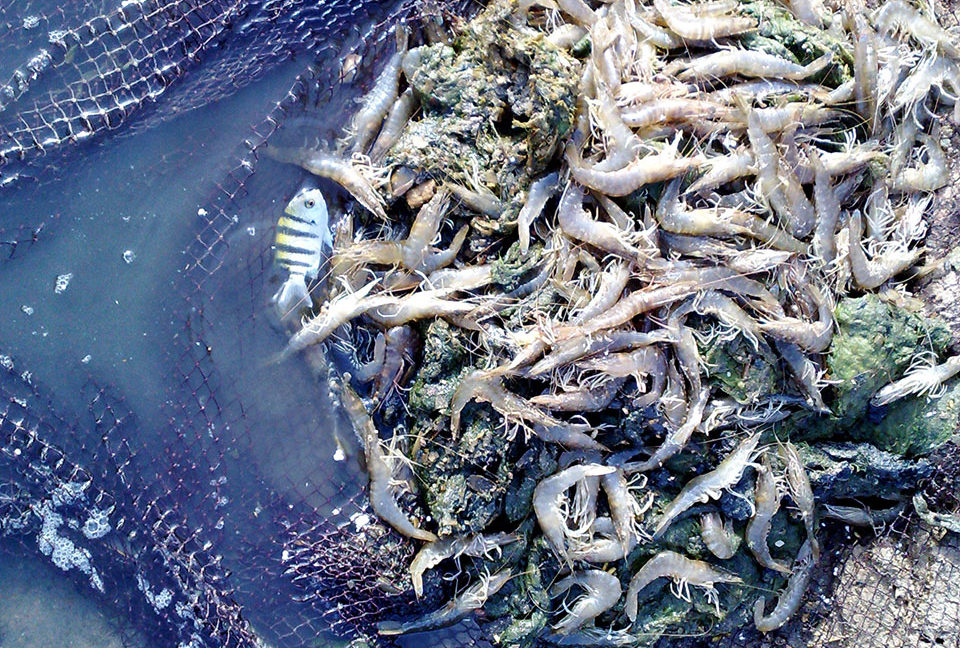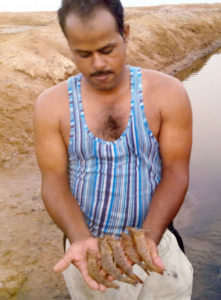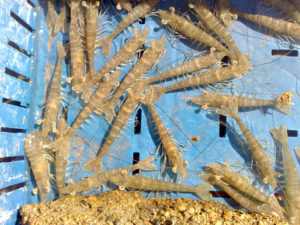Egypt lacks a specialized feed industry to support shrimp aquaculture

To date, shrimp hatcheries in Egypt have been able to supply the demands of commercial farms due to the limited number of working farms in the shrimp industry. In the future, however, with intensification of shrimp farming in Egypt, a reliable source of postlarvae for the grow-out sector will be needed.
The advantages of domesticated broodstock include the reliability of supplies of postlarvae, the ability to control the time of stocking and improvements in the profitability and sustainability of farming. Domestication programs are now working under bio-secure conditions to produce high-quality, disease-free shrimp postlarvae.
In a trial, the authors examined the feasibility of domestication of green tiger shrimp (Penaeus semisulcatus) as a source for suitable seedstock.
Shrimp trial
Both wild and pond-reared broodstock were used in the trial. On-farm closed-cycle production of P. semisulcatus for two generations was achieved, growing the shrimp from eggs to reproductive adults. Second-generation, fast-growing and pathogen-free shrimp were selected from shrimp grow-out ponds. Wild broodstock were obtained from a commercial trawler from the Gulf of Suez.
Three different matings were compared for reproductive performance: wild males with wild females, pond-reared males with pond-reared females and wild males with pond-reared females. All matings of P. semisulcatus were spawned and gave comparable numbers of eggs and nauplii, which indicated the use of domesticated, pond-reared broodstock could be a sustainable alternative to wild broodstock in Egypt.
Broodstock management

Elastomer tags were injected horizontally, parallel to the body axis, under the ventral cuticle of the shrimp’s sixth abdominal segments. These tags are externally visible for identification of individual broodstock. Adult shrimp were conditioned and acclimatized for a period of one month before spawning. Spawning was based on a 1:1 ratio of males to females to maximize the size of the genetic sample from each population. Seventy-five individuals of each sex were mated to produce each type of offspring.
Females of each spawning group were separated according to degree of sexual maturity into groups with no visibly developed ovaries, developing ovaries or mature ovaries. Developing (pre-vitellogenic) ovaries were translucent and unpigmented, and visible only as an opaque line. Mature ovaries were yellow or green in color and clearly visible through the animals’ exoskeletons.
Morphometric measurements were done on developing or mature ovaries. Seven measurements were made on each female specimen: spawning weight, tail volume, head length, tail length, maximum head thickness, thick tail thickness and maximum thickness of the sixth somite.
Morphometric measurements were taken for males and females of the different broodstock of P. semisulcatus used in the study. Males were generally smaller than females in both wild and domesticated broodstock. On the other hand, body weights were generally the same between females of the different broodstock and between males of the different broodstock.
These were very important points in reaching the conclusion that variations in reproductive performance were mainly due to the broodstock type used and not variations in body weight (Table 1).
Megahed, Reproductive performance of Penaeus semisulcatus, Table 1
| Broodstock Pairings | Spawn Weight (g) | Eggs/Spawning | Hatch Rate/Spawning (%) | Nauplii/Female |
|---|
Broodstock Pairings | Spawn Weight (g) | Eggs/Spawning | Hatch Rate/Spawning (%) | Nauplii/Female |
|---|---|---|---|---|
| Wild male/wild female | 29.02a ± 5.74 | 298,817a ± 790 | 60.25 ± 5.31 | 23,042 ± 9,958.52 |
| Pond-reared male/pond-reared female | 30.72a ± 4.90 | 248,519b ±1750 | 75.82 ± 6.12 | 29,263.16 ± 14,270.57 |
| Wild male/Pond-reared female | 30.65a ± 5.19 | 30.65a ± 5.19 | 70.32 ± 2.09 | 39,000.00 ± 21,075.43 |
Reproductive performance
Reproductive performance for captive broodstock was assessed at a level comparable to broodstock of the same size captured from the wild fishery. The overall naupliar production rate is a function of the spawning rate, the number of eggs per spawning and the hatching success of the eggs produced.

While wild broodstock pairings gave higher numbers of eggs, both pond-reared pairs and wild male/pond-reared female broodstock combinations gave higher numbers of nauplii as a result of slightly higher maturation and spawning rates, a slightly higher number of eggs per spawning and a slightly higher hatching rate (Table 1).
The wild spawner pairs produced the highest mean numbers of eggs per spawning (298,817 ± 790), while the pond-reared broodstock produced significantly fewer eggs per spawning. The hatch rate of eggs was significantly different (P < 0.05) among the three broodstock groups, ranging from a mean of 75.82 ± 6.12 percent for pond-reared broodstock pairs to 60.25 ± 5.31 percent for wild broodstock.
The numbers of nauplii per spawning of the wild male/pond-reared female pairings and pond-reared male and female broodstock were higher than the nauplii production of the wild spawner pairs, but not significantly so.
Perspectives
The shrimp-farming industry in Egypt has experienced unstable development due to several factors. These factors are represented in the lack of experience in marine aquaculture, especially marine shrimp farming. There is no specialized feed industry to support shrimp aquaculture and no research that contributes to solve the grow-out problems.
The domestication of green tiger shrimp could help lead to the expansion of P. semisulcatus farming in Egypt and rapid increases in production. After establishing the feasibility of farm-scale closed-cycle production for P. semisulcatus, there will be potential for selection of the faster-growing shrimp at harvest to produce a potentially faster-growing next generation.
(Editor’s Note: This article was originally published in the September/October 2013 print edition of the Global Aquaculture Advocate.)
Author
-
Mohamed E. Megahed, Ph.D.
National Institute of Oceanography and Fisheries
Gulfs of Suez and Aqaba’ Branch
Suez City, Egypt
Related Posts

Innovation & Investment
Aquaculture Exchange: Sebastian Belle
The executive director of the Maine Aquaculture Association talks to the Advocate about the diverse and growing industry in his state (oysters, mussels, kelp, eels and salmon) and how aquaculture should be used as a rural development tool.

Aquafeeds
Increased density improves grouper feeding response, growth
A growth trial using hatchery-reared grouper was carried out to study the effects of stocking density on feed intake and subsequent growth. Contrary to common perceptions, fish stocked at the highest density had higher feed intake and body weights.

Innovation & Investment
Artemia, the ‘magic powder’ fueling a multi-billion-dollar industry
Artemia, microscopic brine shrimp used as feed in hatcheries, are the unsung heroes of aquaculture. Experts say artemia is still inspiring innovation more than 50 years after initial commercialization. These creatures are much more than Sea-Monkeys.

Health & Welfare
A comprehensive look at the Proficiency Test for farmed shrimp
The University of Arizona Aquaculture Pathology Laboratory has carried out the Proficiency Test (PT) since 2005, with 300-plus diagnostic laboratories participating while improving their capabilities in the diagnosis of several shrimp pathogens.


